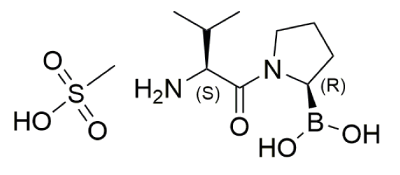Val-boroPro
-
Cat.code:
tlrl-vbp-10
- Documents
ABOUT
NLRP1 inflammasome inducer
Val-boroPro (VbP, Talabostat), a dipeptide boronic acid, is a non-selective inhibitor of various dipeptidyl peptidases (DPPs) including DPP4, DPP8 and DPP9 [1]. It exhibits immunostimulatory properties, notably by disrupting the inhibitory interaction between DPP8/9 and the inflammasome sensor NLRP1 (NLR family member, pyrin domain containing 1). Hence, VbP is a potent inducer of NLRP1 inflammasome responses [1-3]. Moreover, this molecule has been shown to exert antitumor activity in vivo through the induction of cytokines and chemokines that participate in innate and adaptive immune responses [1-2].
Key features:
- Activator of the NLRP1 inflammasome (in human and mice)
- Pyroptosis inducer
- Non-selective inhibitor of serine dipeptidyl peptidases
- Each lot is functionally tested and highly pure (≥95%)
![]() Read our review on NLRP1 & NLRP3 inflammasome sensors
Read our review on NLRP1 & NLRP3 inflammasome sensors
References:
1. Okondo MC et al., 2017. DPP8 and DPP9 inhibition induces pro-caspase-1-dependent monocyte and macrophage pyroptosis. Nat Chem Biol. 2017;13(1):46-53.
2. Adams et al., 2004, PT-100, a Small Molecule Dipeptidyl Peptidase Inhibitor, Has Potent Antitumor Effects and Augments Antibody-Mediated Cytotoxicity via a Novel Immune Mechanism, Cancer Res 64 (15): 5471–5480.
3. Hollingsworth LR et al., 2021. DPP9 sequesters the C terminus of NLRP1 to repress inflammasome activation. Nature. 2021;592(7856):778-783.
All products are for research use only, and not for human or veterinary use.
InvivoGen also offers:
SPECIFICATIONS
Specifications
C9H19BN2O3.CH3SO3H
10 - 100 µM for cell culture assays
40 mg/ml in H2O
cellular assays
Biological activity confirmed using cellular assays, absence of bacterial contamination confirmed using HEK-Blue™ TLR2 and HEK-Blue™ TLR4 cells
CONTENTS
Contents
-
Product:Val-boroPro
-
Cat code:tlrl-vbp-10
-
Quantity:10 mg
Shipping & Storage
- Shipping method: Room temperature
- -20°C
- Avoid repeated freeze-thaw cycles
Storage:
Caution:
Details
VbP (also known as Talabostat, PT-100 or L-valinyl-L-boroproline) is a non-selective DPP inhibitor able to activate both the CARD8 (caspase recruitment domain-containing protein 8) and the NLRP1 inflammasomes [1]. It weakens the inhibitory complex between DPP9 active site and the bioactive C-terminus of NLRP1 by direct competition for DPP9’s catalytic residues. As a result, the single bound C-terminal NLRP1 is released. At the same time, the full length NLRP1 is displaced from the interaction, which leads to auto-proteolysis of its FIIND domain and to proteasomal degradation of the N-terminal domain [3]. The bioactive C-terminal CARD domain is released, activates Caspase-1 via oligomerization with ASC proteins, and subsequently, triggers pyroptosis [2-4].
Additionally, VbP exhibits potent antitumor activity in vivo through the induction of cytokines and chemokines activating the innate and adaptive immune system [2,4]. It also increases the effect of antitumor antibodies like Rituximab and Trastuzumab in xenograft models of human CD20+ B cell lymphoma and HER2+ colon carcinoma, respectively [4].
1. Sato T, et al., 2019. Hatano R, Iwao N, Ohnuma K, Morimoto C. DPP8 is a novel therapeutic target for multiple myeloma. Sci Rep. 2;9(1):18094.
2. Okondo MC, et al., 2017. DPP8 and DPP9 inhibition induces pro-caspase-1-dependent monocyte and macrophage pyroptosis. Nat Chem Biol. 13(1):46-53.
3. Hollingsworth LR, et al., 2021. DPP9 sequesters the C terminus of NLRP1 to repress inflammasome activation. Nature. 592(7856):778-783.
4. Adams et al., 2004. PT-100, a Small Molecule Dipeptidyl Peptidase Inhibitor, Has Potent Antitumor Effects and Augments Antibody-Mediated Cytotoxicity via a Novel Immune Mechanism, Cancer Res 64 (15): 5471–5480.
Chemical structure of Val-boroPro:

DOCUMENTS
Documents
Technical Data Sheet
Safety Data Sheet
Validation Data Sheet
Certificate of analysis
Need a CoA ?

